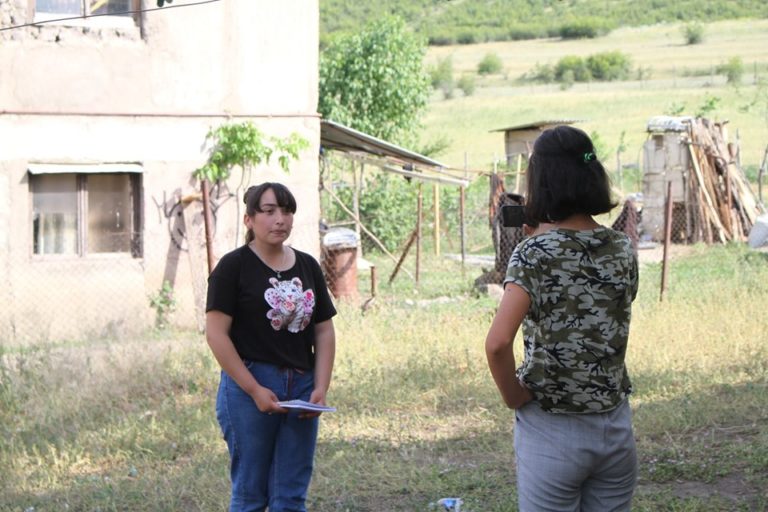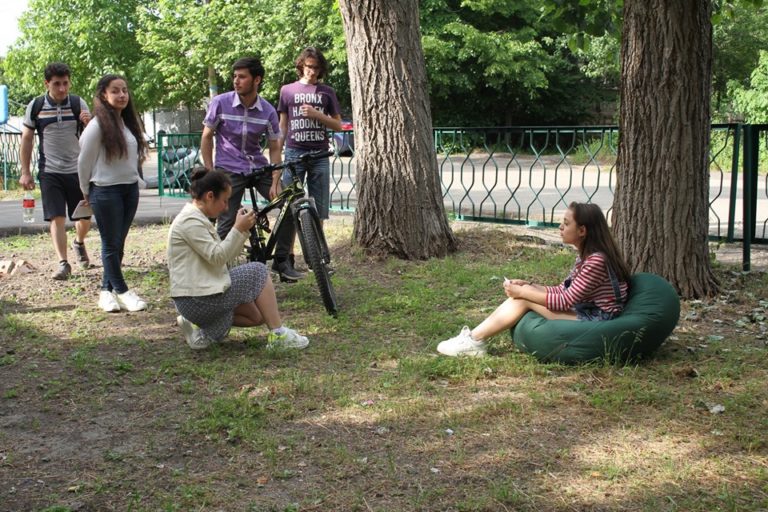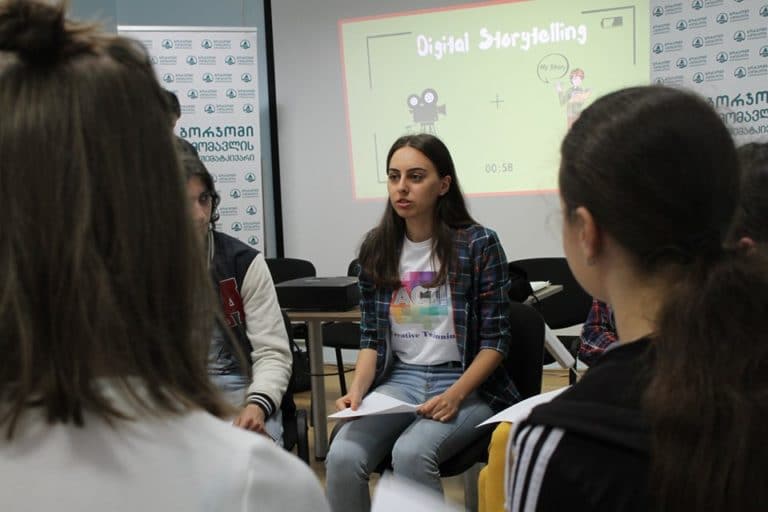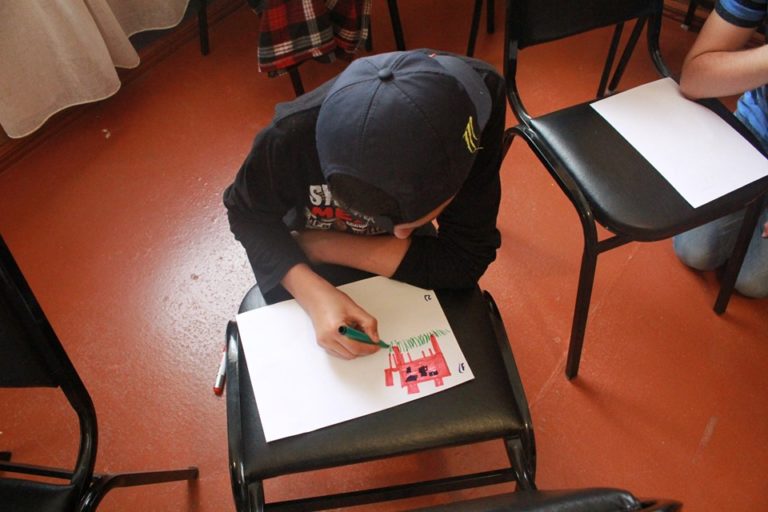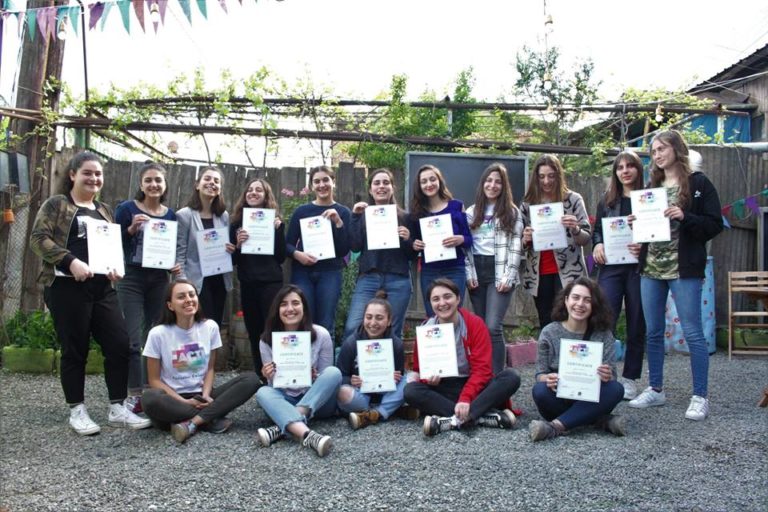Georgia: A Series of Storytelling workshops

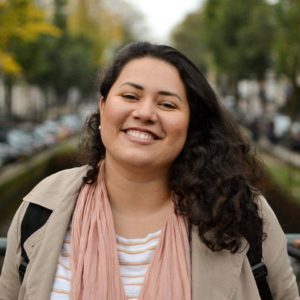
Louise Alves
Talentbanker at MasterPeace Core Team
About the project
The Masterpeace club in Georgia conducted a series of Digital Storytelling workshops around the country this year. After the warm-up activities and training young people’s creative skills, they had as a result many recorded digital stories. These workshops are a part of a long-term project called “Creative Twinning” whose focus is to empower young people and encourage them to participate and be agents of change in their communities.
The workshops happened in 10 different cities in the country and had as its goal to influence young people and train them to use modern methodologies of storytelling. This way, they can share their stories and experiences with each other and with the rest of the world, making use of technology as a catalyst energy for change.
In order to make this happen, Masterpeace club in Georgia established several partnerships with schools, universities, municipalities and youth groups. Those stakeholders have given operational support for the workshops to happen, including finding facilities and helping them to spread the word and recruit young people for the workshops. One of the requirements was that, at least 25% of participants were part of most vulnerable groups in the region, so they could promote opportunities for those with less access to non-formal education.
Overall, based on the reports from the workshops, it is possible to conclude that digital storytelling was not a very well-known tool in the target regions. Introducing this new technique can foster interest in youth work, civic activism and develop social responsibility.
Workshops step-by-step
Starting with Khashuri and ending with Tetritskaro, the workshops were conducted in 10 cities following a particular methodology only with small changes between cities. The whole process of conducting these workshops allowed them to identify better practices and to anticipate obstacles. This way, young people felt more and more comfortable to share their individual experiences and the workshops gained a better flow.
1- Icebreaker
Firstly, the workshop started with a round of introduction where young people share their names, ages and hobbies. This gave them a chance to get to know each other and feel more comfortable speaking in front of the group. By introducing this icebreaker activity, facilitators created an enabling environment for sharing personal stories.
2- A bit of context
As the second step, facilitators gave an introduction the project “ACT!” through a fun and colorful presentation. At this stage, participants learned about the project and its concept of using art to transform local communities towards more inclusive societies. In addition, they were presented with possibilities on how they can engage as young people to change their own communities, always making sure to leave no one behind.
3- Images are worth a thousand words
For the third section of the day, the participants were divided into smaller groups and assigned to facilitators, who distributed A4 papers and colourful markers so participants could draw their own neighbourhoods. For this exercise, they had to draw places they go often; places which are important to them; and places that remind them of special memories. After the set time, they presented their drawings to the group and told the story behind them. The innovative way this activity framed their own experiences, gave them the opportunity opportunity to be familiarised with the concept of storytelling and how to apply it.
4- A letter to yourself
The fourth activity consisted in writing a letter and was slightly different between the cities. In the first workshops they started by asking them to write a letter to a friend with no big purpose – such as asking them to return a borrowed object. Later on, they changed the activity to writing a letter to yourself. In all cases, the letters would be private and they could only be shared if they wished so. This allowed them to be more familiarised with the process of telling a story, now through writing. Another important observation during this phase was that, when given more specific instructions, young people were more imaginative and creative, allowing them to reach better results.
5- Camera & action!
The fifth and last step was the implementation phase. It started with a brief introduction to the methodology of Digital Storytelling and how it applied to youth. Moving from there, facilitators assisted the participants to record their digital stories by giving them detailed instructions and questions for them to answer. The results were amazing stories in form of videos of the participants sharing deeply personal, but only a small part of their lives experiences.
Impact and transformation for change
Analysing the reports, it is possible to notice that in most places, the workshop were their first contact with digital storytelling or even with non-formal education. For that reason, the activities had a huge impact in the participants’ abilities to come out of their comfort zone, become more confident and to empathise with other people’s stories. It was clear that the proposed methodology succeeded in opening their minds and creating a space to instigate curiosity and respect to others.
However, more than personal transformation, the workshops transformed them into agents of change within their own communities. By recording their own stories and listening to the others’, young people were able to improve their sense of self-worth. Understanding that your own story is worth telling can transform you into a more confident human being fostering leadership skills that leads to social change.
Moreover, it is important to highlight the power of digital tools to help them build tolerance, respect and acceptance to different values and behaviours. At the end of the day, having such tools can encourage them to be more active and involved in projects capable of transforming the society they are embedded in. By doing so, their communities will benefit with social inclusion, solidarity and sustainability. Once the videos gathered in all the workshops are shared, the stories’ impact will become even bigger, being able to influence and inspire people also on a global level.

